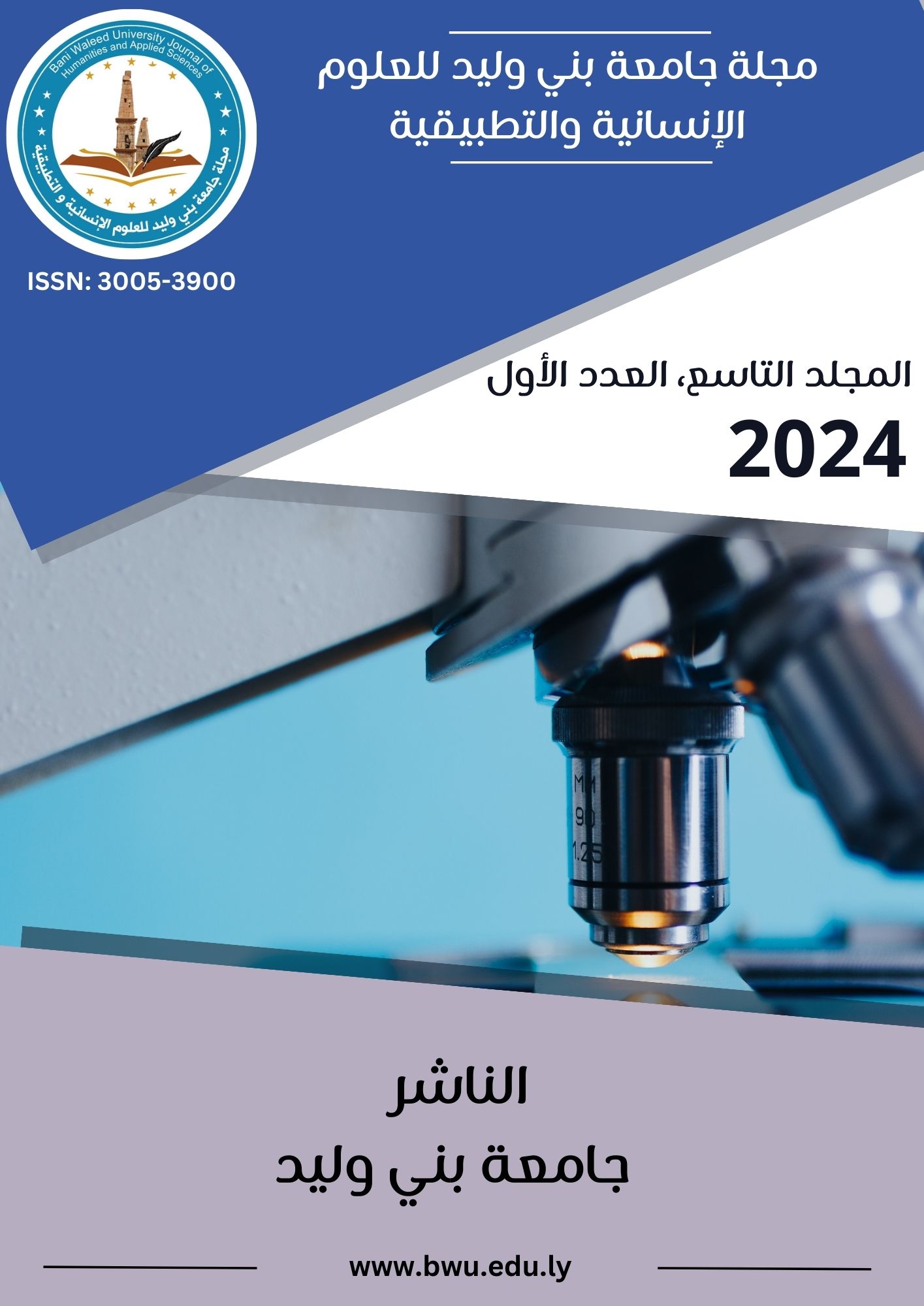Epidemiological Profile of COVID-19 Pandemic and Risk Factors Associated with Infection in Al-Riyayna City of Libya
DOI:
https://doi.org/10.58916/jhas.v9i1.232Keywords:
Epidemiological situation, Corona virus, infection, Al-Rayina city, preventive measures.Abstract
The objectives of this study are to determine the epidemiological situation of virus infection through the period of pandemic and risk factors associated with COVID-19 infection in Al-Riyayna city of Libya. Methods: In this retrospective descriptive study were reviewed records of samples collected from November 2020 to October 2021, were analyzed to determine the risk factors Age groups, sex, and monthly weather associated with infection in the city of Al-Riyayna. Statistical analysis was performed using SPSS version 26 descriptive statistics, using chi-square analysis investigate the level of association among variables at the significance level of P≤ 0.05. Results: The current study reported (1430; 22.1%) positive at (P≤ 0.05), Females showed higher positivity rate compared to males (839; 58.7%, 591; 41.3%) respectively . of all positive COVID-19 cases, most infections occurred in the age groups (15–44 years) as compared to other age groups, the highest number was among age group 25–34 years (330; 23.1%). During study period was two waves of highest positivity rate of COVID-19 cases were recorded, the first wave occurred in November 2020 (250; 17.5%), then the rate begin to decrease until the February 2021 (62; 4.3%). The second wave was in March 2021, the rate of infection increase until April rate reached to 275 cases (19.2%). Conclusion: Based on our data, have demonstrated the significant effects and high cumulated prevalence of COVID-19 of age and gender. Consequently, it is recommended to take preventative in elderly individuals and asymptomatic cases lies in the fact that it may be a carrier of the COVID-19 virus, which exposes other groups to infection.
Downloads
References
Zhou P, Yang X. L, Wang, X.-G., Hu, B., Zhang, L., Zhang, W., Si, H.-R., Zhu, Y., Li, B., & Huang, C.-L. A pneumonia outbreak associated with a new coronavirus of probable bat origin. nature 2020;579:7798.
WHO (2020). Director-General’s remarks at the media briefing on 2019-nCoVon February 11.
ICTV (2020). The species severe acute respiratory syndrome-related coronavirus: classifying 2019-nCoV and naming it SARS-CoV-2. Nat. Microbiol. 5, 536–544.
Wong C. K, Wong J. Y, Tang, E. H., Au, C. H., & Wai, A. K. Clinical presentations, laboratory and radiological findings, and treatments for 11,028 COVID-19 patients: a systematic review and meta-analysis. Scientific reports 2020;10:1.
Yang X, Yu Y, Xu, J., Shu, H., Liu, H., Wu, Y., Zhang, L., Yu, Z., Fang, M., & Yu, T. Clinical course and outcomes of critically ill patients with SARS-CoV-2 pneumonia in Wuhan, China: a single-centered, retrospective, observational study. The lancet respiratory medicine 2020;8:5.
WHO (2020). Coronavirus disease 2019 (COVID-19).
Elhadi M, Momen A. A, Abdulhadi O. M. A. S. A COVID-19 case in Libya acquired in Saudi Arabia. Travel medicine and infectious disease 2020:37.
Alhudiri I. M, Ramadan A. M, Ibrahim, K. I., Eljilani, M., Aboud, A. A., Salem, M. A., Elgheriani, H. M., El Meshri, S. E., & Elzagheid, A. Whole-genome sequencing of SARS-COV-2 reveals a substantially lower frequency of the UK variant than previously announced in Libya. medRxiv 2021.
Peiris J. S, Yuen K. Y, Osterhaus, A. D., & Stöhr, K. The severe acute respiratory syndrome. New England Journal of Medicine 2003;349:25.
Gerna G, Campanini G, Rovida, F., Percivalle, E., Sarasini, A., Marchi, A., & Baldanti, F. Genetic variability of human coronavirus OC43‐, 229E‐, and NL63‐like strains and their association with lower respiratory tract infections of hospitalized infants and immunocompromised patients. Journal of medical virology 2006;78:7.
Fehr A. R, Perlman S. Coronaviruses: an overview of their replication and pathogenesis. Coronaviruses: methods and protocols 2015.
Kammon A, Giweli A, Erhouma, E., Rammah, E., Elusta, A., Knifo, S., Ali, W., Benbubaker, W., Ebrahim, F., & Elarabi, A. Epidemiology of SARS-CoV-2 and Emergence of UK Variant in Zintan City of Libya. Open Journal of Epidemiology 2021;11:04.
Maetouq H. M, Mahmoud A. S, El Salem, A., Aisawi, K. A., Naass, A. A., Alkeelani, A. M., & Abushhewa, M. E. Preliminary Epidemiological Investigation of SARS-CoV-2 and Risk Factors Associated with Infection in Tarhouna, Libya. Fortune Journal of Health Sciences 2021;4:3.
Daw M. A, El-Bouzedi A. H, Ahmed M. O. The epidemiological and spatiotemporal characteristics of the 2019 novel coronavirus disease (COVID-19) in Libya. Frontiers in Public Health 2021;9.
Owusu M, Sylverken A. A, Ankrah, S. T., El-Duah, P., Ayisi-Boateng, N. K., Yeboah, R., Gorman, R., Asamoah, J., Binger, T., & Acheampong, G. Epidemiological profile of SARS-CoV-2 among selected regions in Ghana: A cross-sectional retrospective study. PLoS One 2020;15:12.
Naseem N, Thakur R, Sadhu, R., & Jindal, M. Presentation, Clinical Course and Outcome in Hospitalized Patients with Covid-19: A Retrospective Study 2022.
Richardson S, Hirsch J. S, Narasimhan, M., Crawford, J. M., McGinn, T., Davidson, K. W., Barnaby, D. P., Becker, L. B., Chelico, J. D., & Cohen, S. L. Presenting characteristics, comorbidities, and outcomes among 5700 patients hospitalized with COVID-19 in the New York City area. Jama 2020;323:20.
Scully E. P, Haverfield J., Ursin, R. L., Tannenbaum, C., & Klein, S. L. Considering how biological sex impacts immune responses and COVID-19 outcomes. Nature Reviews Immunology 2020;20:7.
Khalifa E, Omrani E, Bashagha M. Clinical Characteristics of Covid-19 in Libya: Case Series 2021.
Arumugam M, Menon B, Narayan S. K. Ambient temperature and COVID-19 incidence rates: An opportunity for. Emerging Microbes & Infections 2020;9:1.
Chen S, Prettner K, Kuhn, M., Geldsetzer, P., Wang, C., Bärnighausen, T., & Bloom, D. E. Climate and the spread of COVID-19. Scientific Reports 2021;11:1.
Bukhari Q, Massaro J. M, D’Agostino Sr, R. B., & Khan, S. Effects of weather on coronavirus pandemic. International journal of environmental research and public health 2020;17:15.















